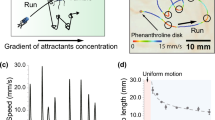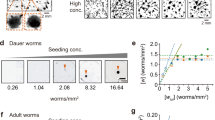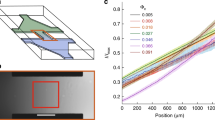Abstract
A STRIKING feature of aggregation in large species of Dictyostelium is the appearance of repeated waves of centripetal movement propagated outwards from the centres1,2. I accounted for them as follows3–8. The cells are not only oriented by the chemotactic agent, acrasin9, but induced to secrete it; they thus relay the orienting signals. The detailed aggregation pattern, before contact modifies it, records the transmission of these signals. To avoid an infinite regress, some secreted factor must induce its own secretion; this was tentatively assumed to be the attractant itself. There would then be separate thresholds for attraction and secretion. The dual responsiveness develops during the preaggregation phase. Aggregation centres are started by the first cells to secrete signals supraliminal for their neighbours. That separate cells, having oriented to the signal and transmitted it outwards, do not reorient to the signal now coming from behind them and transmit it centripetally, was ascribed to some combination of reduced receptor, motor, and secretory activities, expressed as an absolute or relative refractory period, and to changes in cell shape, spacing, orientation, and polarity, once the cells have responded. The precise signal profile may be significant. After an interval, the cells can transmit a new pulse in any direction. Commonly the same cells as before initiate the later pulses and thus remain dominant, but pulses from other pacemakers can recruit and reorient those cells they reach first. Secreted acrasin is rapidly inactivated enzymically. It was argued that this is functionally useful in maintaining the detectability of the signal even with a single source, and vastly more so with literally millions of sources. Enzymic breakdown could also yield a metabolite for recycling. Later work10–12 has very largely confirmed this. The attractant in D. discoideum is cyclic AMP13, and the inactivating enzymes phosphodiesterases (PDE)14–16. Cyclic AMP pulsed from a microelectrode induces propagated waves of movement17. A mathematical model has incorporated most of the above features18. The present work demonstrates directly that cyclic AMP does induce aggregating cells to secrete cyclic AMP.
This is a preview of subscription content, access via your institution
Access options
Subscribe to this journal
Receive 51 print issues and online access
$199.00 per year
only $3.90 per issue
Buy this article
- Purchase on Springer Link
- Instant access to full article PDF
Prices may be subject to local taxes which are calculated during checkout
Similar content being viewed by others
References
Arndt, A., Archs Entw Mech. Org., 136, 681–747 (1937).
Bonner, J. T., Am. J. Bot., 31, 175–182 (1944).
Shaffer, B. M., Science, 123, 1172–1173 (1956).
Shaffer, B. M., J. exp. Biol., 33, 645–657 (1956).
Shaffer, B. M., Am. Nat., 91, 19–35 (1957).
Shaffer, B. M., Q. Jl microsc. Sci., 98, 377–392; 393–405 (1957).
Shaffer, B. M., Q. Jl microsc. Sci., 99, 103–121 (1958).
Shaffer, B. M., Adv. Morphogen., 2, 109–182 (1962).
Bonner, J. T., J. exp. Zool., 106, 1–26 (1947).
Bonner, J. T. et al., Devl Biol., 20, 72–87 (1969).
Gerisch, G., Curr. Top. devl Biol., 3, 157–197 (1968); Naturwissenschaften, 58, 430–438 (1971).
Alcantara, F., and Monk, M., J. gen. Microbiol., 85, 321–334 (1974).
Konijn, T. M., Barkley, D. S., Chang, Y. Y., and Bonner, J. T., Am. Nat., 102, 225–233 (1968).
Chang, Y. Y., Science, 160, 57–59 (1968).
Malchow, D., Nägele, B., Schwarz, H., and Gerish, G., Eur. J. Biochem., 28, 136–142 (1972).
Pannbacker, R. G., and Bravard, L. J., Science, 175, 1014–1015 (1974).
Robertson, A., Drage, D. J., and Cohen, M. H., Science, 135, 333–335 (1972).
Cohen, M. H., and Robertson, A., J. theor. Biol., 31, 101–118 (1971); J. theor. Biol., 31, 119–130 (1971); Robertson, A., and Cohen, M. H., A. Rev. Biophys Bioengng, 1, 409–464 (1972).
Sussman, M., and Lovgren, N., Expl Cell Res., 38, 97–105 (1965).
Malkinson, A. M., and Ashworth, J. M., Biochem. J., 134, 311–319 (1973).
Chi, Y. Y., and Francis, D., J. cell. Physiol., 77, 169–174 (1971).
Mason, J. W., Rasmussen, H., and Dibella, F., Expl Cell Res., 67, 156–160 (1971).
Gerisch, G., and Hess, B., Proc. natn. Acad. Sci. U.S.A., 71, 2118–22 (1974).
Konijn, T. M., Biol. Bull., 134, 298–304 (1968).
Author information
Authors and Affiliations
Rights and permissions
About this article
Cite this article
SHAFFER, B. Secretion of cyclic AMP induced by cyclic AMP in the cellular slime mould Dictyostelium discoideum. Nature 255, 549–552 (1975). https://doi.org/10.1038/255549a0
Received:
Accepted:
Issue Date:
DOI: https://doi.org/10.1038/255549a0
This article is cited by
-
Interplay of mesoscale physics and agent-like behaviors in the parallel evolution of aggregative multicellularity
EvoDevo (2020)
-
Effects of sodium azide and trifluoperazine on growth, development and monolayer cell differentiation inDictyostelium discoideum
Journal of Biosciences (1995)
-
Dual role of cAMP duringDictyostelium development
Experientia (1995)
-
Novel oscillations in cell suspensions ofDictyostelium discoideum
Experientia (1990)
-
Behavioral studies into the mechanism of eukaryotic chemotaxis
Journal of Chemical Ecology (1990)
Comments
By submitting a comment you agree to abide by our Terms and Community Guidelines. If you find something abusive or that does not comply with our terms or guidelines please flag it as inappropriate.



